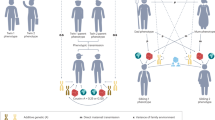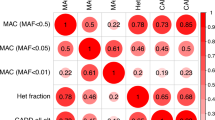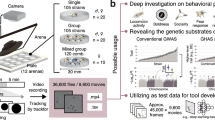Summary
The conditions are discussed under which the regression (bD/S) over a range of environments of the difference between two genotypes, X and Y, on their sum will be linear. It is shown that if the slope of this regression falls outside the range – 1 to 1, the two genotypes must be responding in opposite directions to the changes in the environment. The relations of bD/S to bY/X and bX/Y, the regressions of X and Y on one another, are derived and the effects of error variation are considered. The three regressions are derivable from one another in principle, and the most useful values will be obtained by estimating from the data the one which is least subject to distortion by error variation and deriving the others from it. The best starting point will commonly, but not always, be bD/S.
The treatment is extended to the analysis of multi-line experiments, due to Perkins and Jinks, in which each line is regressed on the mean of them all. It is shown how estimates of such regressions, not open to the statistical objections of regressing a variate onto another of which it itself is a part, can be obtained by starting with the regression of each line on the mean of the rest. The value of bD/S for any pair of the constituent lines can be derived directly from the multi-line analysis, and indeed once the analysis is available any group of lines can be readily compared with any other such group.
Similar content being viewed by others
Article PDF
References
Bucio Alanis, L. 1966. Environmental and genotype-environmental components of variability: I. Inbred lines. Heredity, 21, 387–397.
Bucio Alanis, L, and Hill, J. 1966. Environmental and genotype-environmental components of variability. II. Heterozygotes. Heredity, 21, 399–405.
Bucio Alanis, L, Perkins, J M, and Jinks, J L. 1969. Environmental and genotype-environmental components of variability. V. Segregating generations. Heredity, 24, 115–127.
Freeman, G H. 1973. Statistical methods for the analysis of genotype-environment interactions. Heredity, 31, 339–354.
Freeman, G H, and Perkins, J M. 1971. Environmental and genotype-environmental components of variability. VIII. Relations between genotypes grown in different environments and measures of these environments. Heredity, 27, 15–23.
Hardwick, R C, and Wood, J T. 1972. Regression methods for studying genotype-environment interactions. Heredity 28, 209–222.
Mather, K, and Jones, R M. 1958. Interaction of genotype and environment in continuous variation. I. Description. Biometrics, 14, 343–359.
Mather, K, and Vines, A. 1952. The inheritance of height and flowering time in a cross of Nicotiana rustica. Quantitative Inheritance (ed. E. C. R. Reeve and G. H. Waddington), pp. 49–80, H.M.S.O., London.
Perkins, J M, and Jinks, J L. 1968a. Environmental and genotype-environmental components of variability. III. Multiple lines and crosses. Heredity, 23, 339–356.
Perkins, J M, and Jinks, J L. 1968b. Environmental and genotype-environmental components of variability. IV. Non-linear interactions for multiple inbred lines. Heredity, 23, 525–535.
Yates, F, and Cochran, W G. 1938. The analysis of groups of experiments. J agric Sci, 28, 556–580.
Author information
Authors and Affiliations
Rights and permissions
About this article
Cite this article
Mather, K., Caligari, P. Genotype × environment interactions. Heredity 33, 43–59 (1974). https://doi.org/10.1038/hdy.1974.63
Received:
Issue date:
DOI: https://doi.org/10.1038/hdy.1974.63
This article is cited by
-
Inter-site transferability of crop varieties: another approach for analyzing multi-locational variety trials
Euphytica (1996)
-
Environmental sensitivity and heterosis for egg laying in Drosophila melanogaster
Theoretical and Applied Genetics (1989)
-
The significance for breeding of linear regression analysis of genotype-environment interactions
Heredity (1976)
-
Bias in the estimation of regression coefficients in the analysis of genotype-environmental interaction
Heredity (1976)
-
Genotype×environment interactions
Heredity (1975)



